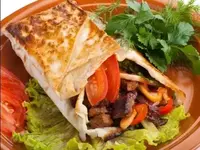The latin american

The cuisine of Latin America is a whole layer of culinary traditions of several bright and distinctive republics. Colombia, Argentina, Brazil, Chile, Cuba, Uruguay, Mexico and Peru are part of the Latin American region that lies on the continent of South America.
The indigenous people of these countries began to grow corn as the main rural and economic crop in Antiquity. Therefore, to date, most Latin American recipes use corn.
Residents of the region have long learned to use all the useful qualities of corn when preparing Latin American dishes. Corn is used to make the main dishes, side dishes to the main dishes, and corn flour is used to bake delicious and therefore incredibly popular tortillas tortillas. Tortillas have long been a Latin American dish in their own right.
When preparing a corn tortilla, seasonings and spices are put in the dough, then lubricated with oil or eaten with cheese or hot sauces. Latin American cuisine is not conceivable without an abundance of spices and spices. When preparing Mexican dishes, chefs never break the main rule of good taste. One dish should have at least 5 types of spices.
Mostly Latin American dishes contain components such as mint, basil, sage, thyme, basil and pepper. The most famous kind of pepper among Latin American countries is the famous jalapeno. Equally famous Chili peppers are also common in Latin American dishes. In the state of Chile itself, 70 varieties of this pepper are found in cooking.
Latin American recipes often use tomatoes and potatoes, as well as legumes. Red beans and beans are no less popular with Hispanics than corn. Let's not forget that the Latin American region includes similar states, cultures and nationalities in one, but completely different in the other.
It is worth noting that the national cuisines of Latin American countries such as Cuba, Brazil and Mexico have much in common. The inhabitants of these territories were able to combine in the recipes of their national dishes the traditions of both indigenous people (Indian tribes) and European colonists (Spaniards and Portuguese) and emigrants (Italians).
Cubans and Mexicans prefer to cook meat (pork and beef) over an open fire. Thus, cooked meat and a special tomato sauce with the addition of spices and seasonings is considered a favorite treat. The national cuisine of Brazil has absorbed the main features of Latin American culture. But Brazilians decided to bring even more variety to their dishes.
Currently, Brazilian cuisine is among the most popular in the world. Brazilian cuisine is a colorful mosaic from the culture of the indigenous people of Brazil and European traditions. African slaves and Asian immigrants brought to the continent also made a noticeable contribution.
In Latin American cuisine, drinks occupy a special place. Coffee is considered the most popular drink. The famous Brazilian and Colombian coffee became famous all over the world thanks to its unforgettable aroma and unique invigorating taste.
In Latin American recipes, alcoholic beverages are a common ingredient. Hispanics use wine for cooking. In red wine of various strengths and types, meat is marinated, and white wine is added to sauces or confectionery.
Most countries in the Latin American region make extensive use of fish and seafood in their diet. Climatic conditions in the countries allow you to grow first-class fruits that are used in the preparation of drinks, desserts and delicious fruit juices and salads.
The abundance of vegetables in the Latin American region opens up great opportunities for a variety of salads. Vegetable salads are filled only with olive oil. It is believed that only such oil can not spoil the dish. Don't forget that Latin American cuisine refers to "fiery" kitchens because of the spices and huge amounts of pepper.
 Español
Español Français
Français Português
Português Русский
Русский 简体中文
简体中文 繁體中文
繁體中文 日本語
日本語 한국어
한국어 العربية
العربية Türkçe
Türkçe Қазақ
Қазақ Deutsch
Deutsch Italiano
Italiano Українська
Українська
